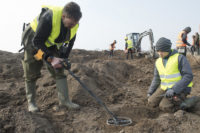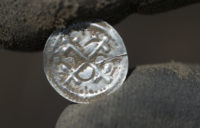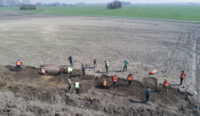 Metal detector enthusiast Rene Schoen and his student, 13-year-old Luca Malaschnitschenko, were exploring a field near the village of Schaprode on the island of Ruegen in Northern Germany when they came across a circular piece of metal. At first Schoen thought it was a random bit of aluminium. After cleaning off some of the dirt and taking a closer look, he realized it was a coin.
Metal detector enthusiast Rene Schoen and his student, 13-year-old Luca Malaschnitschenko, were exploring a field near the village of Schaprode on the island of Ruegen in Northern Germany when they came across a circular piece of metal. At first Schoen thought it was a random bit of aluminium. After cleaning off some of the dirt and taking a closer look, he realized it was a coin.
 Schoen is a volunteer with the Mecklenburg-West Pomerania state archaeology office, so he immediately reported the find. State archaeologists identified it as a silver coin from trading settlement of Hedeby. To prevent the treasure-hunters descending like locusts, they asked Schoen and Malaschnitschenko to keep their find a secret until the Office could arrange a thorough excavation of the site.
Schoen is a volunteer with the Mecklenburg-West Pomerania state archaeology office, so he immediately reported the find. State archaeologists identified it as a silver coin from trading settlement of Hedeby. To prevent the treasure-hunters descending like locusts, they asked Schoen and Malaschnitschenko to keep their find a secret until the Office could arrange a thorough excavation of the site.
 The coin was discovered in January, and archaeologists only broke ground this weekend. Still, in this brief period the team has excavated more than 4,000 square feet of the find site. The results have been nothing short of spectacular. They have unearthed a treasure far beyond the expectations set by a single silver coin, a hoard that could very well have belonged to King Harald Gormsson (r. 958-986), aka Harald Bluetooth, himself.
The coin was discovered in January, and archaeologists only broke ground this weekend. Still, in this brief period the team has excavated more than 4,000 square feet of the find site. The results have been nothing short of spectacular. They have unearthed a treasure far beyond the expectations set by a single silver coin, a hoard that could very well have belonged to King Harald Gormsson (r. 958-986), aka Harald Bluetooth, himself.
Braided necklaces, pearls, brooches, a Thor’s hammer, rings and up to 600 chipped coins were found, including more than 100 that date back to Bluetooth’s era, when he ruled over what is now Denmark, northern Germany, southern Sweden and parts of Norway.
“This trove is the biggest single discovery of Bluetooth coins in the southern Baltic Sea region and is therefore of great significance,” the lead archaeologist, Michael Schirren, told national news agency DPA.
The oldest coin is a Damascus dirham dating to 714 while the most recent is a penny dating to 983.
The find suggests that the treasure may have been buried in the late 980s – also the period when Bluetooth was known to have fled to Pomerania, where he died in 987.
“We have here the rare case of a discovery that appears to corroborate historical sources,” said the archaeologist Detlef Jantzen.